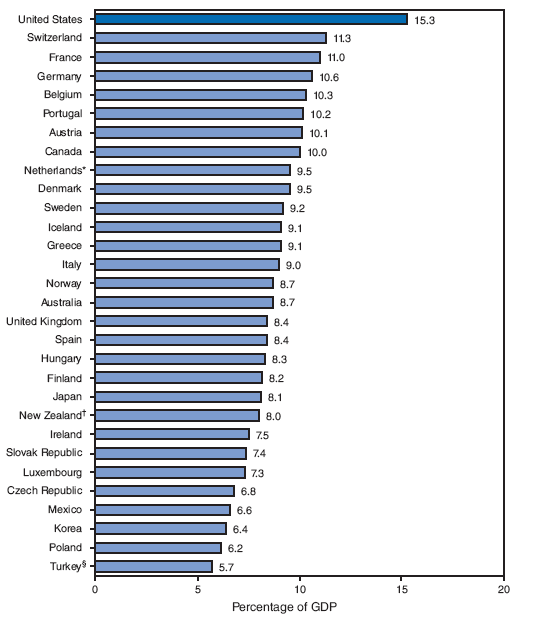The recent Congressional debates over healthcare reform have been a model in special interest lobbying and out of touch representation. Big money in the medical industry is using its influence to make false claims about how expensive public healthcare is or how effective our current American medical system is in keeping people healthy.
If you’ve been reading my sites and posts before, you might be a little bit confused as I usually argue toward the libertarian end of things and now I’m suddenly calling for a public health system. And yes, I might be a little biased against government solutions and market interventions, but we can’t let ideology blind us to the facts.
Fact #1:Â U.S. Spends more of its GDP on healthcare
 The CDC published the 2006 data on health care as a percent of GDP, and its clear that the American version of private for-profit care comes with a higher price tag than comparable medical care in similar nations. In 2008, things were even worse: 17.6 cents on every dollar generated were spent on medical care. If the GDP continues to decline and nothing is done about costs, we will soon spend more than 20% of our GDP on this one expense.
The CDC published the 2006 data on health care as a percent of GDP, and its clear that the American version of private for-profit care comes with a higher price tag than comparable medical care in similar nations. In 2008, things were even worse: 17.6 cents on every dollar generated were spent on medical care. If the GDP continues to decline and nothing is done about costs, we will soon spend more than 20% of our GDP on this one expense.
Fact #2:Â Americans are not Healthier
The CIA World Factbook ranks America at #50 for life expectancy: this is well behind most of the European and Asian nations that we’re outspending. And despite all of the money we’re spending and the attempts to subsidize private profits in the sector, we still have tens of millions of people who can’t get access to the preventative treatments they need to stay healthy and employed.
Fact #3:Â The Status Quo is Bad for Business
Unless you’re in the insurance or pharma industries, the current system is a dead weight on your company’s bottom line. Employees who do get coverage from their jobs are costing a lot of money to their employers, and the annual rise in costs cuts into the same HR budget that would have funded your raise or the assistant you’ve been hoping for.
Workers who don’t have coverage are in an even worse spot, because they often can’t afford to buy insurance. Rather than get treated and tested early, they end up struggling through sickness and eventually showing up at the emergency room in need of urgent care. Of course, that care still has to be paid for – and its still going to come out of the pockets of taxpayers and insurance indirectly.
The Illusion of Competition
We Americans take great pride in the concept of free markets, but what exactly does that mean? One thing implied by a free market economic sector is the presence of competition – something we don’t really have in our for-profit medical system.
If you’re seriously injured in an accident and need emergency surgery, you don’t have time to research your hospital choices. You’re not exactly in a good position to argue with the ambulance driver, either. Likewise, people don’t usually turn down employment because the medical benefits are too expensive or purchased from an unreliable provider.
Yet that’s not it: There are also strict laws, inspired by lobbyists, that prevent insurance from being sold across a national market. State mandates help fragment the insurance market-place, and this generally leaves fewer alternatives based on location.
Healthcare, like roads, is something that everyone needs. There are inherent limitations to how much competition can exist in these markets.
Single-Payer Makes Sense:Â A Public Option is Minimally Acceptable
American healthcare doesn’t demonstrate the cost savings expected of a free market, and the result lags behind nations with public systems. The current model leaves little incentive for early (and often cheap) cures, because there is a lot of profit to be made on patients with chronic illnesses and chronic pain. Instead, surgery is a big ticket item, and some are often oversold.
It is also important to remember that a public single-payer system does not mean the total elimination of private insurance options. Just because everyone would be covered for basic necessities does not mean that affluent individuals couldn’t find extra insurance. In France, a vast majority of the population still carries private insurance supplements.
If a single-payer system is too radical of a change for the American public, the minimum acceptable choice is a competing public insurance option. If provided at cost, this federal insurance plan would force the private insurance industry to cut costs and provide better care.
Conversely, any attempt at universal healthcare that does not include public competition will simply subsidize the insurance companies even more – and mostly at the expense of the lower working class. Some proposals have amounted to forcing everyone who works at McDonalds and Wal-Mart to buy their own insurance – and while it sounds absurd, it would be great business news for the stock owners of private medical companies. Of course, the stock owners’ club includes more than a few members of Congress so the chances of this happening are higher than I’d like to admit.
The bottom line is this: We need to slash healthcare costs and all indications are that a non-profit public competitor is the way to go. We need to stop asking if we can afford universal coverage and start asking if we can afford to go without it any longer.

Pingback/Trackback
Obama Aproval Rate Dropping – Is he too Conservative? - John McDonald